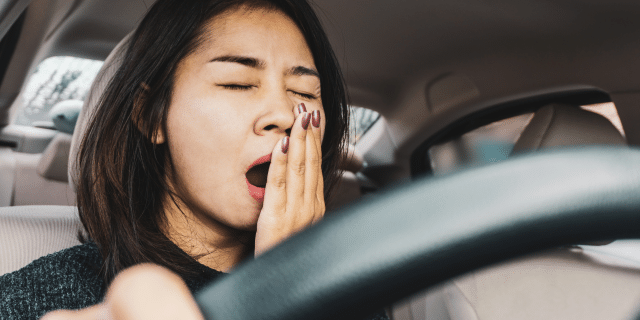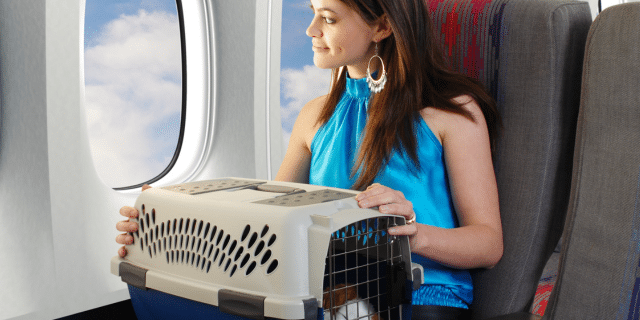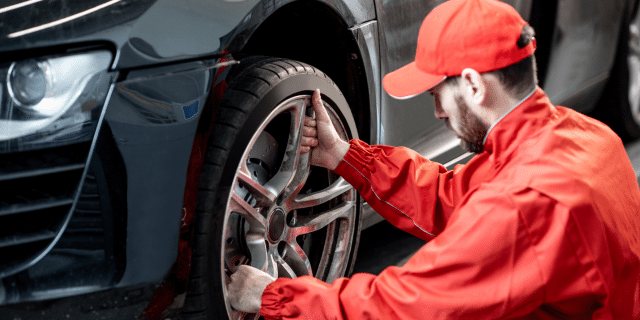
by California Casualty | Auto Insurance Info, Safety |
When the rest of the world is winding down, you’re just gearing up—saving lives, keeping streets safe, answering calls, and making sure others get the care they need. Whether you’re a nurse on the night shift, a paramedic racing the clock, or a police officer patrolling quiet streets, late-night and long-shift driving comes with its own set of challenges. Fatigue, low visibility, and unpredictable road conditions can all put you at risk. That’s why staying alert—and staying safe—behind the wheel is just as important as the job you’re heading to.
The Reality of Night Shift Driving
According to the National Highway Traffic Safety Administration (NHTSA), night shift workers are three times as likely to be involved in drowsy driving crashes. Most of these accidents occur between midnight and 6 a.m.—the time when your body naturally wants to sleep due to your circadian rhythm (your internal biological clock). That’s why it’s essential to have a safety plan in place before you start your engine.
Quick Fixes to Stay Alert After a Long Shift
Take a short nap before you leave.
Even 15 to 30 minutes can make a difference. A quick rest can reduce sleepiness and give you a safer start to your drive.
Why It Works: A power nap (15–30 minutes) allows your brain to enter the early stages of non-REM sleep, reducing sleep pressure and boosting alertness without entering deep sleep, which can cause grogginess. It restores neurotransmitter balance and improves reaction time—essential for a safe drive home.
Move before you cruise.
Before you get into the car, try stretching or walking briskly to activate your body and brain.
Why It Works: Physical activity increases blood flow and oxygen to the brain, boosting alertness by stimulating the release of norepinephrine and dopamine. Movement also raises core body temperature slightly, which can enhance wakefulness.
Skip the heavy meals and late caffeine.
Heavy meals can make you sluggish, and caffeine too close to bedtime can interfere with your post-shift rest. Save your sleep—and your stomach.
Why It Works: Heavy meals, especially those high in fats and carbs, divert blood flow to the digestive system, leading to a “food coma.” Meanwhile, caffeine has a half-life of about 5–7 hours, and late intake can block adenosine receptors, disrupting sleep cycles and impairing recovery.
Crunch it out.
Keep crunchy snacks like carrots, granola, or even ice handy as you drive. The chewing motion and texture engage your senses and help you stay alert.
Why It Works: The act of chewing stimulates the trigeminal nerve, increasing blood flow to the brain. Crunchy textures and repetitive motion provide sensory input that can help maintain alertness.
Phone a friend.
A conversation can stimulate your brain and help keep you focused. Bonus: it’s a great way to stay connected during off-hours.
Why It Works: Talking with someone activates multiple brain regions including the prefrontal cortex, responsible for attention and decision-making. This kind of mental activity keeps your brain busy in a good way—making it less likely to fall into microsleep.
Get moving at red lights.
Take advantage of stoplights to stretch, drum on the steering wheel, or do a little seated dance. Getting your blood flowing helps you stay awake.
Why It Works: Even small physical movements can activate your nervous system, raise your heart rate, and help you feel less tired. These brief bursts of activity can break up long periods of sitting and help prevent drowsiness while driving.
Let the fresh air in.
Roll down the window or blast the A/C. A blast of cold air to the face can help jolt you awake.
Why It Works: Breathing in cold air wakes up your body by stimulating a nerve in your face and the part of your brain that keeps you alert. It works like a small jolt, triggering your body’s alert system.
Belt it out.
Sing along to your favorite tunes. It’s almost impossible to drift off while belting out a chorus.
Why It Works: Singing engages multiple brain centers (auditory, motor, and emotional), keeping your brain stimulated. It also makes you breathe deeply, which brings in more oxygen and helps fight off tiredness.
Buddy up.
If possible, carpool with a co-worker. Not only can you take turns driving, but you can also help keep each other alert. Bonus: Carpooling helps reduce your mileage.
Why It Works: Social interaction, shared attention, and the presence of another person can all heighten alertness through increased stimulation of the brain’s executive functions. Alternating drivers can also prevent over-fatigue, reducing the risk of micro-sleeps or delayed reaction times.
Know the Signs of Drowsy Driving
Don’t ignore the warning signs of drowsy driving. If you experience any of these, it’s time to pull over:
- Frequent yawning
- Difficulty keeping your eyes open
- Nodding off
- Drifting from your lane
- Missing road signs or turns
- Inconsistent speed
- Trouble remembering the last few miles
If you’re too tired to drive, don’t push through. Pull over in a safe place and take a nap—even a short one can be lifesaving.
Planning for the Long Haul: Better Sleep for Safer Driving
While short-term tricks can help in the moment, long-term strategies are key for your well-being.
Set a consistent sleep schedule.
Even on your days off, try to stick to the same sleep-wake cycle. This helps train your internal clock and reduces grogginess.
Optimize your sleep environment.
Use blackout curtains, white noise machines, or eye masks to block out daylight and noise. Keep your room cool and tech-free.
Talk to your doctor if needed.
If you’re struggling to sleep despite your best efforts, you may have Shift Work Sleep Disorder (SWSD). A healthcare professional can help you manage it effectively.
You’re the one that others count on—make sure you’re taking care of yourself, too. A few smart habits can help you stay safe behind the wheel and make it home to rest, recharge, and get ready to do it all again.
This article is furnished by California Casualty, providing auto and home insurance to educators, law enforcement officers, firefighters, and nurses. Get a quote at 1.866.704.8614 or www.calcas.com

by California Casualty | Auto Insurance Info, Safety |
There’s nothing quite like prom and graduation season—the photos, the dresses and tuxes, the flowers, the celebrations. But while your teen may be focused on finding the perfect outfit or planning the after party, you’re likely thinking about something else entirely: their safety on the road.
Here are some tips to help your teen navigate prom, graduation, and all the celebrations in between—safely.
1. Make “leaving early” a habit.
Encourage your teen to leave at least 10 minutes earlier than needed—more if weather conditions are poor. This reduces the urge to speed and gives them time to react calmly to traffic or detours. If they’re heading to the same event as many others, they might also encounter fewer cars and pedestrians if they beat the rush.
2. Limit passengers.
It’s fun to pile into a car with friends, but the more people you have, the more distractions the driver encounters. Set limits on how many friends can ride with your teen and remind them that safety comes before socializing.
3. Always buckle up.
Seat belts are simple but lifesaving. Make sure your teen—and everyone in their car—buckles up before the engine starts. Reinforce the message that seat belts are non-negotiable, even for short trips.
4. Phones down, eyes up.
Phones are one of the biggest distractions for drivers, especially teens. Talk with your teen about putting their phone away while driving. There are apps that can silence notifications, send automatic replies, and even block texts while the car is in motion. Sharing their location with you is also a smart move in case you need to reach them in an emergency.
5. Minimize all distractions.
Texting isn’t the only distraction. Eating, drinking, adjusting the music, or checking makeup can all take attention off the road. Remind your teen to stay focused and wait until they’re parked to multitask.
6. Don’t drive while drowsy.
With finals, late-night celebrations, and packed schedules, your teen may not be getting enough sleep. Driving tired is just as dangerous as driving under the influence. If they feel themselves nodding off, they should pull over in a safe place and rest before continuing.
7. No drinking and driving—ever.
This one may seem obvious, but it bears repeating. Teens should never get behind the wheel after drinking or using any substance. Have an open conversation about peer pressure and agree on a “safe word” they can use if they need you to pick them up—no questions asked.
8. Keep an emergency kit in the car.
Whether it’s a flat tire, dead battery, or a minor fender bender, your teen should know what to do in case of a car emergency. Pack a basic kit with a flashlight, jumper cables, water, a first-aid kit, and emergency contact numbers. Make sure they know how to use everything in it. Teach your teen basic vehicle care and warning signs.
9. Be accident-ready, just in case.
Teens are often accident-prone because of their inexperience behind the wheel. Make sure your teen knows what to do if they’re ever in a crash. Go over the basics together: stay calm, check for injuries, move to safety, call 911, and exchange information with the other driver. Keeping an emergency kit in the car and insurance details in the glove box can also help them feel more prepared and confident.
10. Set a curfew.
More than 40% of fatal crashes involving young drivers happen between 9 p.m. and 6 a.m. It’s not just the challenge of driving in the dark—late-night trips are often social outings where distractions and peer pressure can run high. Even rule-following teens can be tempted to take risks. Setting an earlier curfew than your state requires can help keep your teen safer. Bonus: Offer to drive them and pick them up for late night outings.
11. Control the keys.
When teens have to ask for the car, it naturally opens the door for conversation. It’s a built-in pause that gives parents a moment to check in—about where they’re headed, who they’ll be with, and when they plan to return. It’s also a subtle reminder that driving is a privilege, not a right, and that responsibility comes with it. Keeping the keys in your hands helps reinforce expectations and encourages accountability.
12. Monitor risky behavior.
Consider a monitoring device or app that can track risky behaviors such as speeding, abrupt acceleration and sudden braking. You can also keep tabs on your teen’s location with GPS tracking. Some systems have a silent alarm so your teen can signal SOS if they feel unsafe.
Finally, this is a good time to review your insurance. Is your teen properly covered? Have you discussed all the ways you can save with a teen driver? Ensuring your policy is up to date can give both of you peace of mind during this high-risk season.
Prom and graduation are once-in-a-lifetime milestones, and you want your teen to enjoy them to the fullest—safely. Start the conversation early, model safe driving behavior yourself, and let them know you’re always just a phone call away. Your guidance and trust go a long way in helping them make smart decisions behind the wheel.
This article is furnished by California Casualty, providing auto and home insurance to educators, law enforcement officers, firefighters, and nurses. Get a quote at 1.866.704.8614 or www.calcas.com.

by California Casualty | Helpful Tips, Homeowners Insurance Info |
If clutter has crept into every corner of your home, spring is your golden opportunity to clear it out and start fresh. This season isn’t just about cleaning—it’s about creating space for what truly matters. Whether you’re dreaming of tidy shelves, organized closets, or just a little more breathing room, these smart decluttering tips will help you reduce the mess and refresh your mindset.
Where to Start
The clutter didn’t happen overnight—and it won’t disappear overnight either. That’s okay! Decluttering is a process, not a race. Here’s how to get started:
- Pick one clutter hotspot—a shelf, drawer, or closet. Starting small builds momentum.
- Set a timer for 15, 30, or 60 minutes—whatever works for you. This helps keep you focused and prevents burnout.
- Take before-and-after photos. You’ll be amazed at the progress, and it’ll keep you motivated.
- Enlist help. A friend or family member can make the process more fun—and help you decide what stays and what goes.
- Create a home inventory. As you declutter, jot down big-ticket items or anything valuable. It can come in handy for insurance purposes.
Want a broader strategy? Check out our blog on Easy Ways to Declutter Your Home. For now, here are room-by-room tips to guide your spring-cleaning mission.
General Decluttering Tips
Use the Four-Box Method: Label boxes or bins as Trash, Give Away, Keep, and Relocate. Sort items accordingly.
- Clear surfaces: Flat spaces attract clutter. Find permanent spots for items or consider letting them go.
- Ditch the broken stuff: If it’s beyond repair (like a broken umbrella or snapped sunglasses), it’s time to toss it.
- Let go of guilt items: If you’ve been holding on to something out of guilt—not love—donate it.
Entryway
Clear the catch-all zone: This area often becomes a drop zone. Use bins, hooks, or a small table to keep it tidy.
- Sort the mail daily:
- Open and sort as soon as you walk in.
- Create a system for bills, items to respond to, and recycling.
- Avoid the dreaded mail mountain!
Kitchen
Spices: Toss any older than a year. No scent = no flavor.
- Refrigerator and freezer: Discard expired or mystery items.
- Cookbooks: Keep only your go-to favorites. Donate the rest.
- Takeout menus and condiments: Menus are online; sauces don’t last forever—ditch the extras.
- Appliance manuals: Recycle any available manuals online. Organize your appliance warranties.
- Specialty appliances: If you haven’t used it in the past year, it may be time to let it go.
- Under the sink:
- Organize essentials within reach.
- Relocate overflow items to a closet or garage shelf.
- Drawer clutter: Use dividers for utensils, tools, and gadgets.
- Mugs: Keep your favorites. Donate duplicates.
Bathroom
Clear containers: Transparent acrylic bins let you see what you have.
- Sort by category: Hair, dental, skincare, first aid—group like with like.
- Makeup:
- Mascara: Replace every 3 months
- Foundation/Concealer: Replace annually
- Lipstick, eyeshadow, blush: Replace every 2 years
- Donate unused items in good condition.
- Medications:
- Dispose of expired or unidentifiable meds safely. Local police stations often have drop-off bins.
- Eyewear: Donate old prescription glasses and frames.
Bedroom
Clothing
- Organize by type: Lay out all jeans, skirts, or shirts. Keep what you love, donate the rest.
- One-year rule: Haven’t worn it in a year? It’s probably time to part ways.
- Donation bin: Keep a labeled bin in your closet so it’s easy to add items as you go.
Shoes and Socks
- Toss worn-out or single shoes.
- Donate pairs you haven’t worn in a year.
- Bye-bye, lonely socks! Toss any that don’t have a match.
Playroom
- Toys:
- Donate those your child has outgrown.
- Toss games with missing or broken parts.
- Crafts:
- Contain supplies to a shelf or bin.
- Use small containers or drawer organizers for easy access.
- Prevent duplicate purchases by taking inventory.
- Artwork:
- Display your child’s favorites.
- Repurpose others as wrapping paper or recycle.
Office
Receipts:
-
- Scan important ones and toss the rest.
- Remember: thermal paper isn’t recyclable.
- Cords and chargers:
- Sort, label, and get rid of the mystery wires.
- Make sure your extension cords are in good working order.
- Files and papers:
- Shred what you no longer need.
- Store important documents in labeled folders.
Books: Keep the ones that hold sentimental value or that you plan to reread. Donate the rest.
- Remote controls: Recycle the ones you no longer use.
- Media: Donate or sell CDs, DVDs, and other outdated formats.
Old paint: If it’s dried out or more than a few years old, it’s probably time to toss it (check local disposal guidelines).
- Tools:
- Hang them on utility racks or pegboards.
- Organize by type and label for easy access.
- Boxes: Go through those mystery boxes—keep what matters, recycle the rest.
Keep Clutter from Coming Back
One-in, one-out rule: For every new item you bring in, donate or discard one.
- Daily donations: Give away one item per day—365 things gone in a year!
- Avoid unnecessary freebies: Don’t bring home samples or giveaways unless you’ll use them.
- Think before bulk buying: Only stock up on what you actually use regularly.
- Reusable bags: Store them in your car so you don’t keep collecting new ones.
- Evening reset: Take five minutes before bed to clear surfaces and put things back where they belong.
Spring is the perfect time to not only declutter but to reevaluate your protection at home. A clean, organized home paired with the right insurance coverage provides the ultimate peace of mind.
This article is furnished by California Casualty, providing auto and home insurance to educators, law enforcement officers, firefighters, and nurses. Get a quote at 1.866.704.8614 or www.calcas.com.

by California Casualty | Pets, Travel |
Whether your pet is a seasoned jetsetter or a first-time flyer, navigating air travel with a four-legged friend takes planning, patience, and know-how. From booking the right seat to ensuring a smooth security check, here’s how to make flying with your pet a paws-itively stress-free adventure!
Cabin or Cargo? Choosing the Best Travel Option
Your pet’s size will determine whether they can fly in the cabin with you or if they must go in cargo. Cargo is not for every pet, and if you must consider it, make sure to check with your vet that it is safe for your pet’s breed, age and health.
Carry-On Pets:
- Pets in the plane’s cabin are limited to cats and small dogs meeting size requirements.
- Your pet must remain in a carrier under the seat in front of you for the flight.
- Some airlines allow you to purchase an extra seat for your pet carrier. You still will need to keep your pet in the carrier, and you also will need to place the carrier under the seat during takeoff and landing.
- Choose a window or aisle seat which will have the most room to stow your pet’s carrier under the seat. Avoid emergency exit rows and bulkhead seats.
- A pet fee applies. Check with the airline for the exact amount.
Cargo Travel:
- Larger dogs must fly in cargo, which is the space at the bottom of the plane where luggage is stored.
- While cargo is ventilated, it is not temperature controlled, and airflow is not the same as in the cabin. Pets may not be allowed in cargo during extreme heat or cold.
- Short-nosed breeds like bulldogs, pugs, and Persian cats are at higher risk for breathing issues and should never fly in cargo.
- Pets must be placed in cargo-approved kennels. Check your airline for specifications.
- While most pets travel safely in cargo, poor ventilation or mishandling can pose risks.
- Most airlines are required to report on companion animal safety. Check your airline’s safety record before booking your pet in cargo.
- A pet fee also applies.
Service Dogs:
- Service dogs are an exception to the pet traveling policies. They are allowed to be out of a carrier but must not block the aisle. Generally, they are not allowed on seats.
- To qualify as a service dog, they must be fully trained and certified to assist a person with a disability.
- Emotional support animals are considered pets and not service dogs. They must follow standard pet travel guidelines.
- Service dogs will usually fly free of charge.
Booking Your Flight
- Research quarantine, vaccine, and other restrictions for your destination so you will have the right paperwork.
- Always communicate with the airline in advance. You don’t want any surprises.
- Book direct flights. There is less chance of handoffs going wrong.
- For cargo, if traveling in the summer, pick early morning or evening flights to avoid the hottest parts of the day. In winter, book midday flights to avoid the cold.
Prepping Your Pet for Takeoff
Before your trip, make sure your pet is in tip-top shape for travel. Here’s how:
- Vet Visit: Schedule a checkup to ensure your pet is healthy enough to fly. Some destinations require a health certificate issued within 10 days of travel.
- Skip Sedatives: Tranquilizers can affect breathing. Ask your vet for guidance on whether you should use them. You also can consider pet calming chews with melatonin or chamomile. For nervous cats, try pheromone sprays to help ease anxiety.
- Microchip & ID: Make sure your pet’s microchip info is up to date and their collar includes both your home address and temporary travel address.
Helping Your Pet Adjust to Air Travel
Crate Training: Get your pet comfortable with their travel carrier well in advance. Reward them with treats and praise.
- Crowd Exposure: Airports are busy and noisy! Take your dog to a crowded, dog-friendly area to get them used to similar sights and sounds.
- Practice Security Checks: TSA requires pets to go through security outside of their carrier. Practice taking your pet in and out calmly.
Packing List: Don’t Forget These Essentials
Proof of vaccinations and vet contact info
- Microchip number and pet license
- Airline-approved carrier (waterproof & spacious enough for your pet to stand, turn, and lie down)
- Collapsible water bowl
- Small bag of food in case of delays
- Treats and chew toy (helps with pressure changes)
- Poop bags and pet wipes for clean-ups
- Extra collar and leash
- A recent photo of your pet (for ID purposes)
Pro Tip: For pets traveling in cargo, freeze water in the collapsible water bowl. This will help prevent spills. By the time your pet is thirsty, the water will have defrosted. You can also attach a water bottle dispenser.
Airport Tips: Navigating the Terminal with Your Pet
Strange sounds, sights and smells can be challenging even for the most well-trained pet. Changes in diet and water also can affect your pet. Here are some ways to navigate specific issues with traveling.
Skip Breakfast? A light stomach may help prevent nausea—check with your vet.
- Pre-Flight Potty Break: Ensure your pet relieves themselves before heading to check-in.
- Cargo Flyers: Label crates with LIVE ANIMAL in large letters and add arrows to indicate the upright position. Attach a photo of your pet, and line the bottom with towels. This will help absorb any liquids if there are accidents. You will be dropping off your pet at the check-in counter along with your luggage.
- Cabin Flyers: Be prepared to remove your pet from the carrier for TSA screening. Once through security, locate pet relief areas before boarding.
- Alert the Flight Crew: If your pet is traveling in cargo, notify a flight attendant so they’re aware. They should be able to confirm that your pet is safely on board.
- Meet Your Pet: The airline will direct you to a place where you can meet your pet and show them some love following your flight.
Are you flying with small children, too? Check out our blog on Flying with Kids.
Travel with Peace of Mind
Finally, don’t forget to protect your fur baby with pet insurance for added peace of mind, and to save on your vet bill. Remember, you can easily add pet insurance from Pet’s Best to your California Casualty auto or home policy. Find out more about what pet insurance can cover by talking with a California Casualty customer service representative today.
This article is furnished by California Casualty, providing auto and home insurance to educators, law enforcement officers, firefighters, and nurses. Get a quote at 1.866.704.8614 or www.calcas.com.

by California Casualty | Auto Insurance Info |
Imagine walking out to your car, only to find it sitting on cinder blocks—your wheels gone without a trace. Wheel theft is on the rise, and thieves are getting faster and bolder. Here’s how to protect your vehicle from becoming an easy target.
Why Are Wheels and Tires a Target for Thieves?
Wheels and tires are some of the easiest and most profitable car parts to steal.
- Quick and Easy to Remove: With a jack and an impact wrench, thieves can steal a full set of wheels in as little as 10 minutes.
- No Serial Numbers: Unlike other car parts, wheels and tires don’t have identifying numbers, making them nearly impossible to track.
- High Resale Value: Stolen wheels and tires can be sold quickly, often for hundreds or even thousands of dollars.
How to Prevent Wheel Theft
If your wheels are stolen, you’re looking at a hefty bill to replace them—not just for the wheels and tires, but also for any damage caused during the theft. The key to protecting your wheels is making your car a more difficult target. Here are some effective strategies.
1. Use Lug Nut Locks
Thieves must remove the lug nuts to access your wheel. Make that task impossible by replacing one lug nut on each wheel with a locking nut that requires a special key to remove. These are widely available at auto stores and provide an added layer of security. However, be sure to store the key in a safe place—you’ll need it when you change a tire.
2. Install a Tilt Sensor Alarm or Dash Cam
Consider a tilt sensor alarm that sounds off when it detects changes in the vehicle’s angle, such as when a thief attempts to jack it up. Similarly, you may want a dash cam with motion sensors to record any suspicious activity. When you purchase an aftermarket alarm, make sure it syncs with your car’s existing alarm system. You may need to take it to your mechanic to get it professionally installed so it will work on your vehicle.
3. Use Smart Parking Strategies
Where and how you park can make a big difference:
- Choose well-lit, high-traffic areas. Thieves prefer working in the shadows and avoiding locations with security cameras or frequent foot traffic.
- Park close to the curb. Positioning your car so that the wheels are near the curb makes it harder for thieves to use a jack.
- Turn your wheels. Angling your wheels at a 45-degree angle toward the curb makes it more difficult to access the lug nuts, as the inner fender will block them.
- Park in the garage. If you have access to a garage at home, park your vehicle inside so it is out of sight with no easy access for thieves.Cover Your Car
A vehicle cover can deter thieves by concealing your wheels and adding an extra step they may not want to take. While not foolproof, it’s another barrier that could make your car less attractive to criminals.
4. Use a Wheel Lock Boot
For added protection, especially if you’ll be leaving your car parked for an extended period, consider investing in a wheel lock boot. Like those used by parking enforcement, these devices prevent the wheels from turning. While they require time and effort to install, they are a significant deterrent to theft.
5. Start a Neighborhood Watch
Share contact information with your neighbors so you can communicate if something happens. Encourage them to keep an eye out on your street. Use your neighborhood text chain, Ring doorbells or apps like NextDoor to report suspicious activity.
If Your Wheels Are Stolen
Even with the best precautions, wheel theft can still happen. If you have been a victim, take these steps:
1. Call the Police and File a Report
Report the theft immediately. Provide details such as the make and model of your vehicle, where it was parked, and any security footage or eyewitness accounts. A police report is crucial for insurance claims and potential recovery.
2. Contact Your Insurance Company
If you have comprehensive coverage, your auto insurance may cover the cost of replacing stolen wheels. Provide the police report and any other requested documentation to initiate the claims process.
3. Check for Security Camera Footage
If you parked near a business, apartment complex, or home with security cameras, ask if they captured any footage of the theft. This can help law enforcement identify suspects and track down stolen wheels.
4. Arrange for Temporary Transportation and Repairs
Without wheels, your car may need a tow to a repair shop. Contact your insurance provider to see if they cover towing expenses and explore rental car options while your vehicle is being repaired.
5. Look for Your Stolen Wheels Online
Thieves often sell stolen wheels on online marketplaces like Craigslist, Facebook Marketplace, or local classified ads. If you spot wheels that match yours, notify the police instead of confronting the seller.
Wheel theft is a growing problem, but by taking proactive steps, you can greatly reduce your risk. Protect your car with the right insurance for added peace of mind.
This article is furnished by California Casualty, providing auto and home insurance to educators, law enforcement officers, firefighters, and nurses. Get a quote at 1.866.704.8614 or www.calcas.com.





